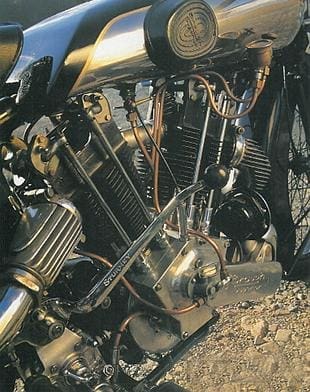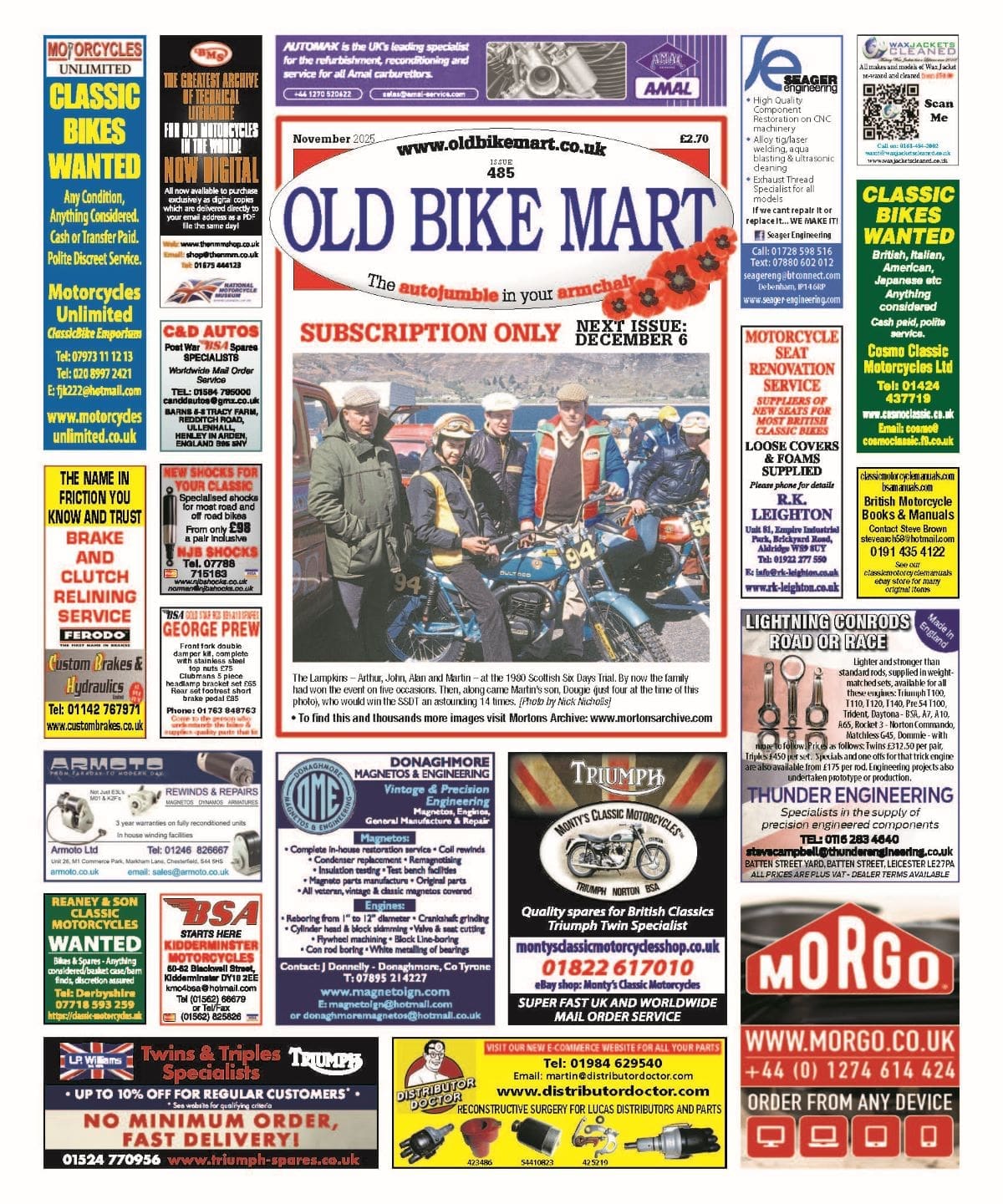
What does the sight of a Brough Superior SS100 make you think about? If your answer is “money, and lots of it” you’re probably not a motorcyclist. Say “Lawrence of Arabia” and you’re getting warmer. But why focus on the marque’s most famous casualty? That’s not cricket.
I like to think of the two people who sum up the SS100 — tuner Bert Le Vack of engine makers J A Prestwich (JAP), and George Brough. It was Le Vack’s world’ s fastest speed on an ohv JAP-engined Brough Superior in 1924 that led super salesman George Brough to market the SS100, a Le Vack replica equally at home on road or track. And the personalities of the two men sum up the JAP-engined SS100. Le Vack was an enigmatic, obsessional engineer, and Brough the most flamboyant of publicists. Yet each man was a perfectionist, and both were racers intoxicated by speed, power and danger. So it’s hardly surprising that a JAP-engined SS100 goes like the devil and looks simply divine.
Even today, not far short of its 70th birthday, the 50-degree vee twin engine in Alan Whitehead’s 1926 SS100 is surprisingly nimble. Loping up the long hill leading out of Bolton ahead of us, I clocked the thundering 980cc SS100 at over 70mph — in second gear. So what’ll it do, Alan?
Enjoy more classic motorcycle reading, Click here to subscribe to one of our leading magazines.
“The first time I rode the Brough I realised that it was far, far quicker than I’d expected,” he says. “The torque is simply amazing, yet the engine seems to be revving so slowly. There was no speedo on it then — and this one’s not connected up yet— so I got a real shock when I looked down at the road and suddenly realised two things. One, I was doing about 80 miles an hour. Two, I had virtually nothing in the way of brakes. Fortunately, I was riding up that hill.”
 Bert Le Vack joined JAP, one of the largest British companies supplying engines to motorcycle makers, in 1922. He had moved from the Indian sales operation in England, and had set a world’s fastest speed of 94.79mph on a special 998cc Indian twin in 1920. Despite a French Huguenot surname, Le Vack was as English as bread pudding, and a wonderfully skilled machinist. With the aid of ace mechanic Sid Moram, he shattered motorcycle speed records left and right in the early Twenties on JAP-powered Zenith and Brough Superior machines.
Bert Le Vack joined JAP, one of the largest British companies supplying engines to motorcycle makers, in 1922. He had moved from the Indian sales operation in England, and had set a world’s fastest speed of 94.79mph on a special 998cc Indian twin in 1920. Despite a French Huguenot surname, Le Vack was as English as bread pudding, and a wonderfully skilled machinist. With the aid of ace mechanic Sid Moram, he shattered motorcycle speed records left and right in the early Twenties on JAP-powered Zenith and Brough Superior machines.
At the same time, he was developing new overhead valve and over-head cam engine designs for JAP to supplement the side-valve units upon which the London factory had built its reputation. JAP needed race and record-breaking successes in order to combat deadly rivals Burney & Blackburn, whose outside flywheel Blackburn singles were gaining a fine reputation for speed. Le Vack’ s engines were very far from production units . But when he established a new world’s maximum of 113.61mph and then promptly trumped that up to 11 9.05mph on oily JAP-engined Brough Superior twins in 1924, George Brough saw his chance.
Now he could use the oily KTOR JAP 8/45 — 8 for its nominal 8 horsepower rating, 45 for 45bhp — in a 100mph missile called the SS 100. Guaranteed as tested to over 100mph, the 1925 SS100 came complete with a bulbous-nosed broad saddle tank and just like Le Vack’s record breaker — was equipped with a Harley-Davidson front fork.
Leading link fork
For use on English roads the short leading link fork had to be fitted with a brake, some-thing Harley didn’t get around to until 1928. Brough’ s version was made in England and marketed as the Castle, but it was still a copy of the American design. Later improvements included the addition of rod-linked friction dampers.
 Although it steers an SS100 to perfection and features long, soft coil springs in its forward members, the fork is simply not sturdy enough to survive the stresses imposed by the powerful front brake that a 100mph machine demands. Even the performance of a 7in Enfield unit fitted to the final 1939 990cc Matchless-engined SS100s is pathetic. The 5in Webb drum on Alan Whitehead’s twin is mere decoration. Fortunately, the Tin unit at the rear works quite well.
Although it steers an SS100 to perfection and features long, soft coil springs in its forward members, the fork is simply not sturdy enough to survive the stresses imposed by the powerful front brake that a 100mph machine demands. Even the performance of a 7in Enfield unit fitted to the final 1939 990cc Matchless-engined SS100s is pathetic. The 5in Webb drum on Alan Whitehead’s twin is mere decoration. Fortunately, the Tin unit at the rear works quite well.
We know a great deal about surviving Brough Superiors. This is partly explained by the low volume of production at Nottingham from 1919 to 1939, but mainly by the survival of Ike Webb’s system of works record cards, established in 1921. Held by the Brough Superior Club, these cards give a full picture of each machine from engine and frame numbers and dispatch date to an individual list of the many optional extras that were part of buying a highly priced bespoke motorcycle.
Many motorcyclists aspire to owning a Brough Superior. Most are content with an example of the most numerous model, the delightful side-valve SS80. Alan Whitehead, who runs the International Classic Bike Show, was much luckier. In 1982 Alan heard that Lancashire Norton enthusiast Eric Biddle wanted to sell the 1926 SS100 he’d bought the previous year. An early JAP-engined SS100 is the most potent of Brough Superiors but (including racers) only 281 were made, so Alan acted quickly.
Famous engine
With the twin came a letter from the BS club’s registrar, Mike Leatherdale, informing Biddle that his SS100 was a bitza with an earlier engine. But KTOR/M 33528 was a famous engine. Originally fitted to an SS100 supplied to Charles Needham in February 1925 and registered as TO 545, this was the twin that had powered Needham to a brief moment of glory on Southport Sands on 12 September that year. In a mile dash between the fastest car and the fastest motorcycle, Needham’s twin beat the bright red supercharged straight six Sunbeam two-litre racing car driven by Sir Henry O’Neal de Hane Segrave. Shortly afterwards Needham met Arline, the American woman who was to become his wife, and sold the SS100.
Needham and his machines — he had previously raced an SS80 — only became famous within BS circles after he movingly recalled his exploits in the club’s bi-monthly newsletter in 1976.
With the help of Brough Superior restorer Tony Cripps, Alan Whitehead slowly returned his machine to the 1926 SS100 Alpine Grand Sports specification you can see here. “He got everything just right, from the mud-guards to the headlamp dipper. That’s what Tony’s really good at,” says Alan.
 Registered as PW 7680, the SS100 Brough Superior had left the Brough works on 16 April 1926, complete with a two-seater sidecar Then it was powered by a JAP twin stamped KTOR/T 57831, and had a Brown & Barlow carburettor. Alan fitted a Binks Mousetrap made for a Brough Superior — the tops of the twin float bowls read Brough Superior Eccles Binks. Even with the compression plates currently fitted under each barrel, the big twin is hard to fire up for someone as lightly built as Alan. But he has experienced none of the idling difficulties that supposedly plague this racing carburettor. He must constantly manipulate the air lever in conjunction with the throttle — and be careful that his left knee doesn’t get sucked against the gaping air intake — but the Binks works well.
Registered as PW 7680, the SS100 Brough Superior had left the Brough works on 16 April 1926, complete with a two-seater sidecar Then it was powered by a JAP twin stamped KTOR/T 57831, and had a Brown & Barlow carburettor. Alan fitted a Binks Mousetrap made for a Brough Superior — the tops of the twin float bowls read Brough Superior Eccles Binks. Even with the compression plates currently fitted under each barrel, the big twin is hard to fire up for someone as lightly built as Alan. But he has experienced none of the idling difficulties that supposedly plague this racing carburettor. He must constantly manipulate the air lever in conjunction with the throttle — and be careful that his left knee doesn’t get sucked against the gaping air intake — but the Binks works well.
Unlike earlier models, the 1926 SS100 has a separate oil tank on the saddle post. The lubrication system is total loss, but economical at almost 1500 miles per pint. A Best & Lloyd pump feeds oil to the crankcase via a sight glass, and there’s an auxiliary band pump. The overhead valve rocker gear must be greased.
The SS100 is fitted with a chain-driven Lucas Magdyno, as it was when new. Alan rarely rides his twin with a battery fitted as it’s so awkwardly sited, between the pillion footrest on the left-hand side and the barrel of the enter.
With a shortish lever low down near the three-speed Sturmey Archer gear-box, many riders use their right feet to change gear on Norton and Broughs Superior models of this period. Alan has tried this method, but prefers a hand change.
He happily admits that he doesn’t know how fast his SS100 goes, but a genuine 110mph should be possible on a clear road. At speed the JAP engine sounds perfectly relaxed, the Brough demonstrating its innate superiority with no discernible effort. View original article


